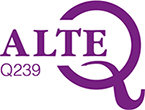When preparing for the ECL language exam it is worth considering the following suggestions that may help candidates successfully complete the language tasks. Independent from the type of exam, it is practical to pay attention to the following:
1. Please check date, time and place of your exam on your notification. It may be that the oral exam and written exam are not held on the same day.
2. Please be on time when arriving at the exam location.
3. It is not necessary to dress up formally – you can wear comfortable clothes.
4. You can bring something to eat and drink for the written exam and may also take these items into the exam room.
5. Read the Exam Regulations before the exam that you agreed to follow when registering.
6. Bring picture identification (ID card, passport, drivers’ licence, residence permit) with you. Student cards are not accepted.
7. Have your notification document printed and bring it with you.
8. On the written communication test (composition) candidates may use printed monolingual and bilingual dictionaries. Thematic dictionaries cannot be used during the exam. The examination sites cannot provide you with a dictionary.
9. Correctors and pens with erasers are not allowed. If you want to correct something in your written answers, make such corrections by crossing out the mistake by pen.
10. If you decide to make a correction in the answer grid of the reading or listening comprehension test paper, the correction must be unambiguous. Cross out the wrong answer. You can take notes and write everywhere on your test paper.
11. For each task, read the instructions.
12. There is an example at the beginning of each task. Read the examples because they help you complete the tasks.
13. Your writing should be legible and clear.
14. If you do not know an answer, guess because points are not deducted for guessing.
Reading Comprehension
1. Before completing the task, read the whole text.
2. It is not necessary to understand the exact meaning of each and every word or expression. Do not be frightened if you come across unknown words in the text. It may be that those parts are not asked about on the test.
3. The order of the questions (items) always follows the order of the text, so you need to find the answer for the first question at the beginning of the text and for the last question at the end.
4. Indicate the places of the text where you can find the answers.
5. Pay attention to the system of references in the text. Look for the cohesive elements. Observe how the topics and the expressions of time change within the text.
6. In case you need to complete a gap-filling type of task, read the whole sentence. The word/expression selected must fit the part of the sentence after the gap, too.
7. Check whether you used each word/expression only once. (Indicate those that you already used.)
8. There are incorrect options for each task: words/expressions/sub-clauses that do not fit anywhere.
9. If there are questions to answer, read the interrogatives because they help you find the right answer.
10. Find the answers in the text and do not try to answer the questions on the basis of your own knowledge.
11. Do your best to give a short answer. If the instruction of the task sets a maximum number of words, do not exceed that number. The number put in brackets after a question indicates the number of elements of a list you are required to mention.
12. You do not need to answer in a complete sentence. Lifting complete sentences, or a whole paragraph from the text, is not accepted as an answer.
13. If the answer is understandable and clear, no point is deducted for making grammatical mistakes. Answers written with incorrect spelling are accepted.
14. Grammatical mistakes do not count as mistakes if it is understandable and clear to what or who the answer refers to and the tense is correct.
Written Communication (Composition)
1. In this part of the exam candidates need to complete two tasks. Start with the one you find easier.
2. It is not necessary to compose a draft, but if you decide to do it, it must also be done on the test paper.
3. Printed monolingual or bilingual dictionaries can be used during the written communication (composition) part of the exam. The use of thematic dictionaries is not allowed. Examination sites cannot provide you with dictionaries.
4. Keep to the number of words designated in the instructions; however, candidates are allowed to deviate from that number by +/- 10%. Articles, complements and the signature at the end are included in the number of words. Numbered lines help you check the number of words in your composition.
5. Read the bullet points carefully. When writing your composition elaborate on all of the bullet points.
6. Structure your writing appropriately and divide your composition into paragraphs.
7. Spelling, grammar and punctuation (full stop, comma, punctuation marks) are assessed on this skill. Leave yourself time to check your composition.
8. Write legibly.
Listening Comprehension
1. The order of the questions (items) always follows the order of the recording.
2. It is not necessary to understand everything, so do not worry if there are parts that you do not understand.
3. Try to answer all the questions after the first listening so you can use the second listening to check or correct your answers.
4. You can take notes while listening to the recording and write down keywords. At the end of the listening you have time to finalize your answers.
5. On the multiple choice tasks pay attention to where the stem leads you.
6. On the multiple choice tasks you need to record your answers (letters) into an answer grid. If you want to make corrections in the grid, make sure to do it clearly. The markers accept only those answers that are unambiguous.
7. The number put in brackets after a question indicates the number of elements of a list you are required to mention to complete the task.
8. You do not need to answer in complete sentences.
9. Grammatical mistakes do not count as mistakes if they are understandable and it is clear to what or who the answer refers to and the tense is correct.
10. Answers written with grammatical mistakes are accepted if the answers can be interpreted and understood clearly.
Oral Communication
1. The date of the oral exam may differ from that of the reading and listening comprehension and written communication parts of the exam (it may precede it).
2. Candidates take the exam in pairs. If you wish, you may indicate your partner when applying for the exam.
3. It is advisable to arrive 20 minutes before the exam starts.
4. It is not necessary to dress formally and you can wear comfortable clothes.
5. Bring a picture identification (ID card. drivers’ licence, passport, residence permit) and your candidate’s ID number with you.
6. The oral exam is recorded.
7. The exam lasts for 20 minutes which includes the assessment of the candidates once they leave the exam room.
8. Your score does not depend on the performance of your partner. The examiners (interviewer and assessor) assess the performance of the candidates individually. If your partner speaks too little or too much, it is the task of the interviewer to establish the appropriate balance.
9. Do not speak in your native tongue or use it to ask for the meaning of a word.
10. The first part of the exam is a warm-up and this part is not assessed.
11. The second part of the exam is a conversation, and you should be active in it. Ask your partner questions, and feel free to contradict or correct. Pay attention to your partner, and react to and comment on what they say.
12. Maintain eye contact with your partner during the conversation.
13. If you notice that you made a mistake, correct yourself immediately or continue the conversation.
14. Do not answer the question with only yes or no.
15. In the third part you need to talk individually about a given topic on the basis of pictures. The interviewer may ask you questions during this monologue.






